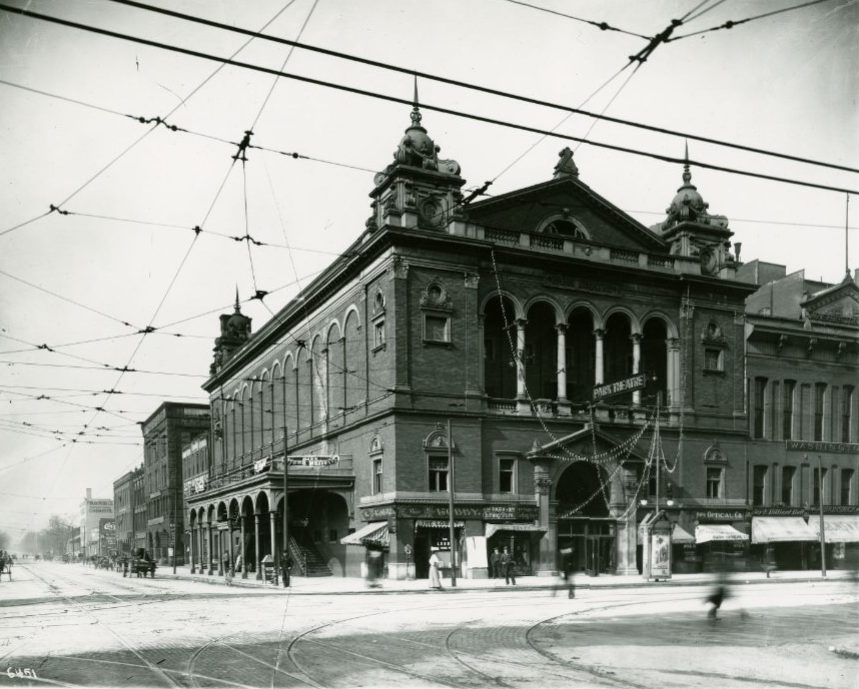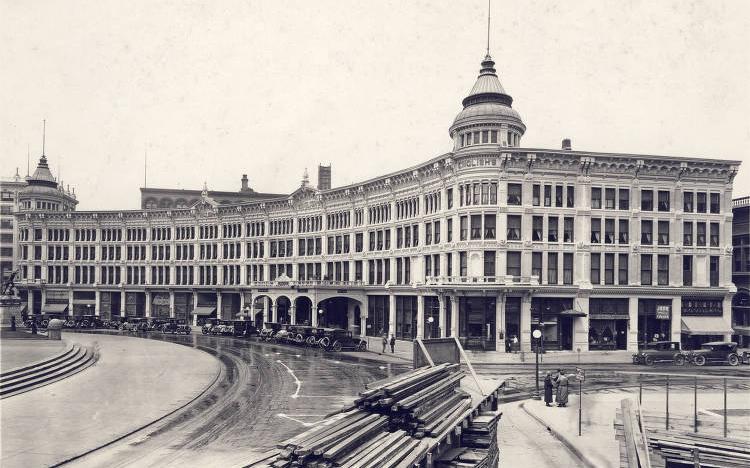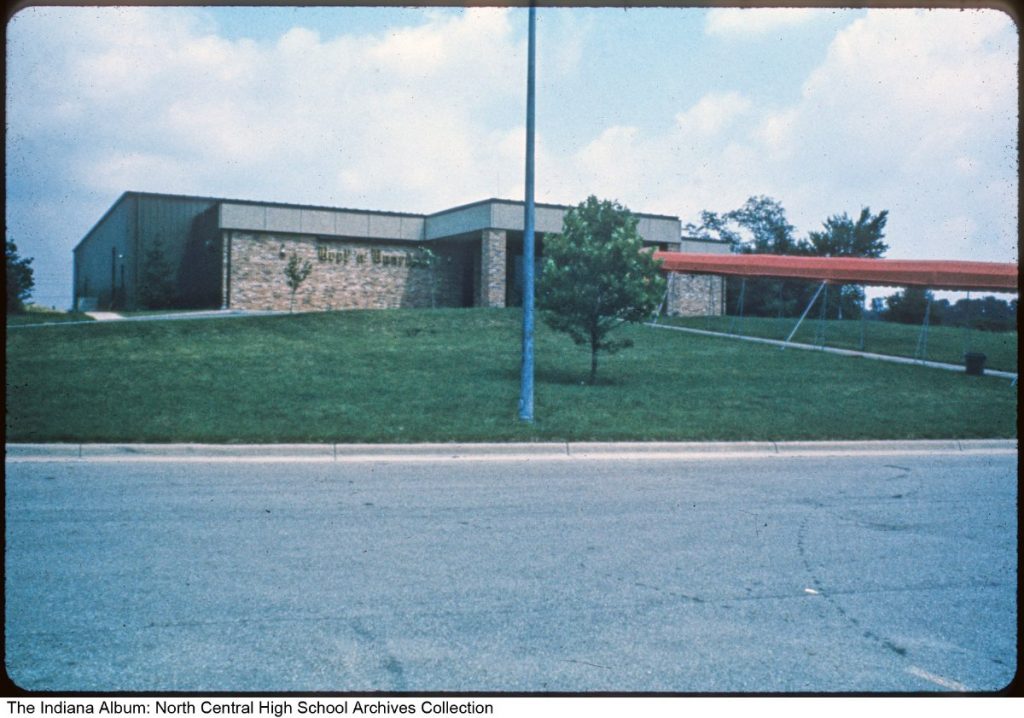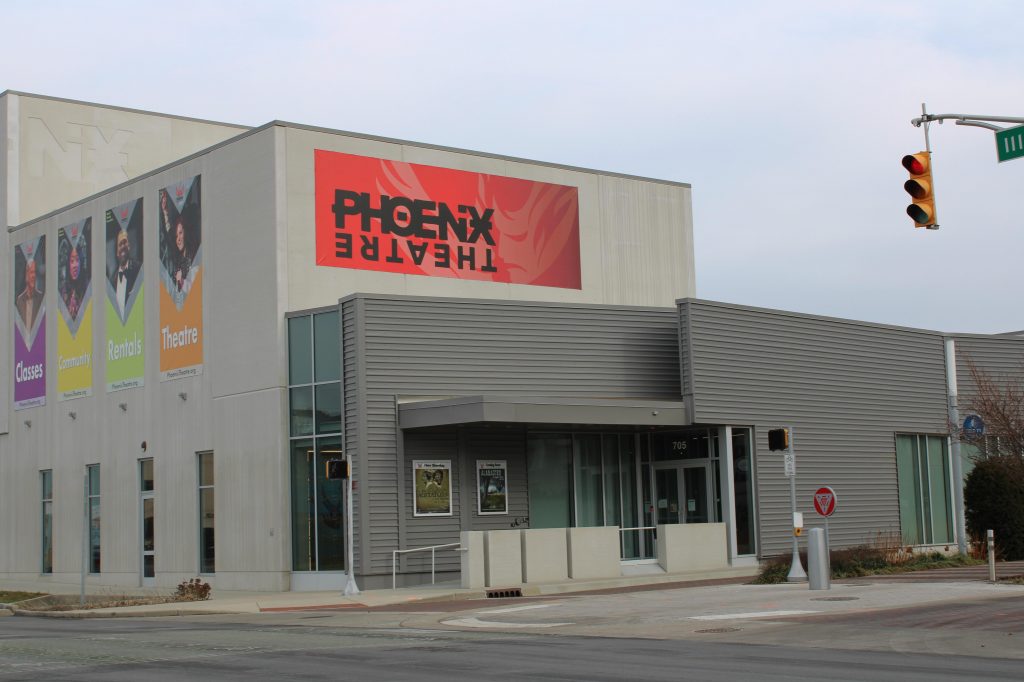Indianapolis’s first theatrical production took place in 1823 on New Year’s Eve. A traveling theatrical troupe performed in the dining room of Thomas Carter’s new tavern, the Rosebush Tavern. Over the next few decades, a variety of theatrical troupes passed through Indianapolis. Performances were staged in churches, the courthouse, an old foundry building, and occasionally in the House of Representatives.
In 1838, another traveling company led by a Mr. Lindsay, performed in makeshift theaters throughout the city. The troupe came from Cincinnati by wagon, bringing scenery in rolls so it could be used in a variety of rooms. Their first theater was Olleman’s wagon shop, where two-inch planks served as seats and tallow candles as footlights. Lindsay’s company returned in 1839-1840, performing in the dining room of Browning’s Hotel. The following year Lindsay adapted the old Indiana Democrat office, a one-story brick building, for use as a theater.
The New York Company of Comedians, managed by John Powell, leased the second story of Gaston’s carriage factory as a theater in 1843-1844. After that, there were no significant productions until 1850 when the new Masonic Hall became the venue of nearly all the city’s entertainment. In 1851, the Masonic Hall even hosted the state Constitutional Convention during the day and a theatrical troupe in the evening.
F. W. Robinson’s company performed at the first in 1852. Robinson later managed a stock company at the just-completed Washington Hall for two seasons, moving to the new Atheneum for the 1854-1855 season. Other managers then leased the Atheneum but without much success.
Mid-to-Late 19th Century
In 1858, Indianapolis finally had its first real theater, the Metropolitan. Valentine Butsch built the 1,500-seat theater, which occupied two upper floors and featured a gallery, vaulted ceiling, and frescoes. It opened on September 27, 1858, with two performances, Love’s Sacrifice (a tragedy written by British playwright John Ford in 1633) and My Neighbors’ Wife (a farce in one act, adapted from a French play by Alfred Bunn in 1800).

The Metropolitan faced some opposition, with Indianapolis residents concerned about the morality of its selection of performances. With this stigma, it would be nearly a decade before Indianapolis warmed to the idea of another theater. In 1867, Morrison’s Opera House opened as the first vaudeville theater in Indianapolis. The Academy of Music, also built by Butsch, opened on September 21, 1868. The Academy’s life was cut short, however, having been destroyed by fire around 1870.
The Indianapolis theater scene continued its growth in the 1870s and 1880s. The Grand Opera House opened at 117 North Pennsylvania Street on September 13, 1875. It featured high-class performances in competition with the Metropolitan. Several buildings in Indianapolis were also converted for theater use in the 1870s: Harmonic Hall, Mozart Hall, Exchange Theater, and Wright’s Hall.
While other theaters were being established during this time, the Metropolitan struggled. Between multiple fires and legal trouble for allowing performers to practice on Sundays (performances were not allowed due to the ), the theater was forced to shutter multiple times. It eventually reopened as Park Theater.
Adding to the now-busy theater scene in the city, the Grand Opera House was built in 1875. In 1880, built , later the English Theater. Not only was the theater modeled on the New York Grand Opera House, but English’s also featured the largest stage in the city. Despite being dubbed “English’s folly” due to the amount of competition in the city, the theater proved successful. In 1886, it was leased to Dickson and Talbott, a theatrical business owned by Fred C. Dickson and Henry Talbott, which then controlled all of the top theaters in Indianapolis until 1897.

With so many theaters in town, there was something for every Indianapolis resident. The English featured top talent while the Grand presented popular vaudeville acts. The Park and the Empire, which opened in September 1892, both provided lower-cost performances. The Empire theater, later renamed the Columbia, was also the first to offer burlesque in Indianapolis.
Theaters with the Advent of Motion Pictures, 1896-1929
The advent of motion pictures changed the theater scene drastically. On November 30, 1896, the Park theater became the first in Indianapolis to show a motion picture by renting the Lumière Cinématographe for two months. Soon after, both the Grand and the Empire theaters, as well as smaller venues, began offering opportunities to see motion pictures. Between 1900 and 1930, nearly 200 theaters opened, most of which were small neighborhood nickelodeons and movie palaces. Several of these new theaters, however, were also designed to accommodate live entertainment. Theaters like the Majestic (later Broadway, then Mutual), the Lyric (1906), and the Colonial (1909) opened during this time and featured a combination of vaudeville acts and motion pictures.
By the 1920s, live performance outlets were having difficulties competing with motion pictures. It was more expensive to produce live entertainment, which resulted in higher ticket prices than movie theaters. Many of these theaters started showing more motion pictures and less live entertainment to stay afloat. Park, which was renamed Capitol in August 1923 (it went through several names–Lyceum in 1913, Strand in 1916, back to Park in September 1916), switched to primarily featuring motion pictures with a house orchestra before going back to live performances.

Loew’s Palace opened in 1921 with vaudeville and film but went to film only for a time. The Indiana and the Walker theaters both opened in 1927, featuring stage performances and motion pictures. The Indiana Theatre later switched to only showing motion pictures. By the late 1930s, the Lyric became one of the only theaters still primarily featuring vaudeville acts.
Closures and Reinvention: 1930-1980
Between the 1930s and 1950s, a few new live performance theaters came on the scene such as the , DeBoest Hall, and the Outdoor Concert Terraces at the Indianapolis Museum of Art (see ) In 1936, Keith’s Theater (previously the Grand) housed the Federal Players, a troupe of the Works Progress Administration’s Federal Theatre Project. The company disbanded in 1937.
Many of the established theaters were either showing motion pictures, relying on burlesque performances, or simply closing. The English theater closed in 1948. The Mutual was able to stay open through its burlesque performances but still closed by the early 1950s. More theaters continued to close into the 1960s and 1970s, including Keith’s in 1964, the Lyric in 1969, and Loews in 1970.
One theater opened in the 1970s. Beef & Boards Dinner Theatre, a chain operation, opened in 1973 on the northwest side of the city. The Indianapolis franchise exchanged hands several times over the next two decades until being owned solely by Douglas E. Stark by 1998. It is now the only Beef & Boards remaining.

Over time, many theaters in Indianapolis have seen several incarnations. Two were restaurants at one time, two became churches, and several became vaudeville, burlesque, and movie houses successively. Most of the marvelous old theaters in Indianapolis were destroyed to make space for businesses, office buildings, or parking lots. A few survived and continued being used as theaters, notably the Indiana theater which became home to the in 1980 (an Equity theater using full-time professionals), and the which managed to maintain its function as a live performance space since its opening in 1910.
Alternative Theaters: 1980-present
The outlook of the theater scene was not completely dire. Several new alternative theaters (theaters that focus on societal issues or that use unusual staging methods) began to pop up in the city in the 1980s and 1990s. founded the notable in 1983. The theatre spent its first five seasons running out of the Ambassador building. This not-for-profit theater brought contemporary works to Indianapolis and eventually grew to also provide acting and playwriting classes.

Another alternative theater entered the scene five years later. Theatre on the Square opened in in 1988 with a focus on unique and original theater. By 1993, the theater moved to a new home on . That same year, Theatre on the Square became home to one of the city’s longest-running shows, ComedySportz. In 2018, after struggling financially, Theatre on the Square partnered with the and to create a new business model, with IndyFringe managing theater operations. As part of this, the theater was renamed The District Theatre.
Even more theaters popped up in the 2000s. IndyFringe held its first festival in August 2005 with over 100 shows performed over 10 days. The festival became an annual summer event with hundreds of live acts performing at theaters all over Indianapolis.
In 2004, the long-running Civic Theatre (founded in 1914) left its previous home at the Showalter Civic Theatre, which was built on the grounds of the Indianapolis Museum Of Art in 1973. After a brief time at the campus, the group found its permanent home at the in in 2011. In 2019, got its little theater. Storefront Theatre operated in a small 50-seat theater with an art gallery and rehearsal space. Its focus was bringing new work by female and minority playwrights to Indianapolis.
Multiple theaters opened in 2020 including the Africana Repertory Theatre of IUPUI (A.R.T.I.) which was developed through the partnership of multiple schools and programs. It was developed to document and reflect the history, cultural life, and politics of peoples of the African Diaspora. The new nonprofit theater, American Lives Theatre, opened as well. The theatre’s first play, Gloria, opened on January 10, 2020, and set the stage for the new theater’s focus on work that reflects the lives of all Americans.

Help improve this entry
Contribute information, offer corrections, suggest images.
You can also recommend new entries related to this topic.